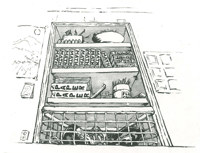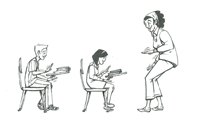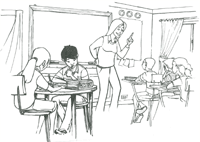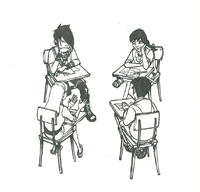Integrated Dynamic Learning
Positive Interventions
The IDL Classroom has many positive interventions.

Smiley Face Mantra is a sticker of a smile attached to the door frame of a classroom. As each student enters the classroom, he states:
“As I smile at this moment. It will bring a smile to the next moment.”

Daily Check-up Card is a 3-x5 card with an outline of a human body. If the student chooses to pickup a Card., he marks the spot on the body where he is hurting and places the card on his desk. As the teacher walks around the room to check on each student’s class work, she glances at the card and sees the mark on the body. Bending down to the student’s level, she says, “I am saddened to know about your hurt.” She then smiles reflectively to the student and moves on to the next student. If the student is functioning at a Bubble Dweller™ level (Level 1), at that moment, the teacher skillfully looks beyond his gaze in order not to “poke” his bubble and says the same above statement. If the mark appears serious, the teacher will send a referral to the principal, vice-principal, school psychologist , social worker or counselor.

Collateral Closet™ is used to minimize the conflict between a teacher and student regarding proper classroom supplies. If a student forgets to bring a pencil, pen, paper or textbook, she goes to the closet where the supplies are kept. She marks on the supply list the items she picked and then places her shoe in a basket located at the bottom of the closet as collateral. At the end of class, the student goes to the Collateral Closet™, returns the supplies, checks the box by her name marked “return” and picks up her shoe.

Rumbling Technique™ is used to assist students to refocus and to calm. They cross their hands and tap their legs, alternating the hand gestures from left to right. This technique comes from the work of Francine Shapiro, Ph.D., who introduced EMDR (Eye Movement Desensitization and Reprocessing), (1987). By tapping the hands left and right, the brain is stimulated to fire neurons from the left and right hemisphere. This process generates emotions which are often felt as body sensations. The students can identify where they feel stressed or anxious. By focusing on their feelings, students can shift from negative emotions and ill-being, to positive emotions. While tapping, students become keenly aware of their breath. They rapidly move from an unfocused shallow breathing, to a more conscious deep breathing. Finding their core of well-being, students often find themselves giggling at the end of the Rumbling session.

Completion Table is situated in the room next to the teacher’s desk. If a student comes to class with incomplete homework, he does not have to feel shame or anxiety; he simply goes to the Completion Table. On the Table are the homework and textbook necessary to complete the assignment. As the teacher explains the homework, those students at the Completion Table follow along and complete their work.
The teacher has no ill-feelings or anger toward the student who did not have his homework. Nor does she elicit an explanation from the student for not having the homework. This eliminates the struggle between student and teacher over missing homework.
The Completion Table is used to emphasize the positive aspect of the homework, rather than the negative response of an “incompletion.” The teacher calmly collects and reviews the homework, marking those answers that are correct and not giving Self-Directive Learning™ points. The student then returns to his desk.

Tribal Pods™ is a formation of four students at different cognitive perceptual, social-relatedness and mindfulness levels. For example, a Tribal Pod named the “Cougars” has a girl with an IDL™ Index of Four in all three domains. Another girl has an IDL™ Index of two. One boy has an IDL™ Indexs of Two in Cognitive Perception and Social-Relatedness, and an index of One in Mindfulness. The fourth student, a boy, had an overall IDL™ Index of Three. The students in each Pod name their Pod, make a shield to represent their tribe and situate their desks in a circle or square format.
Download the Integrated Dynamic Learning document plus appendices and glossary. Download IDL Appendix C and IDL Appendix E.